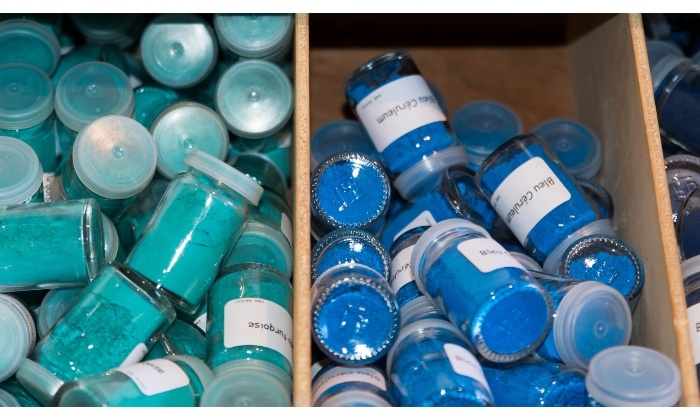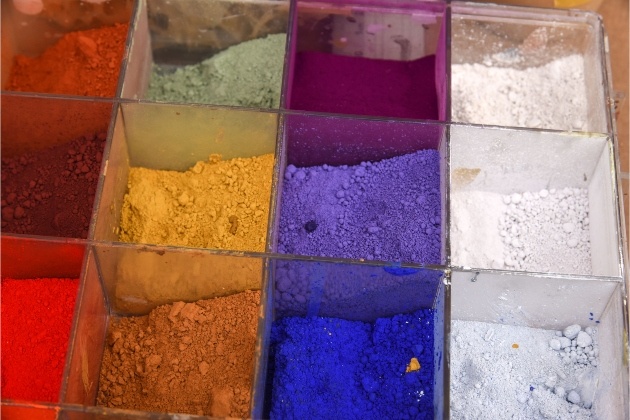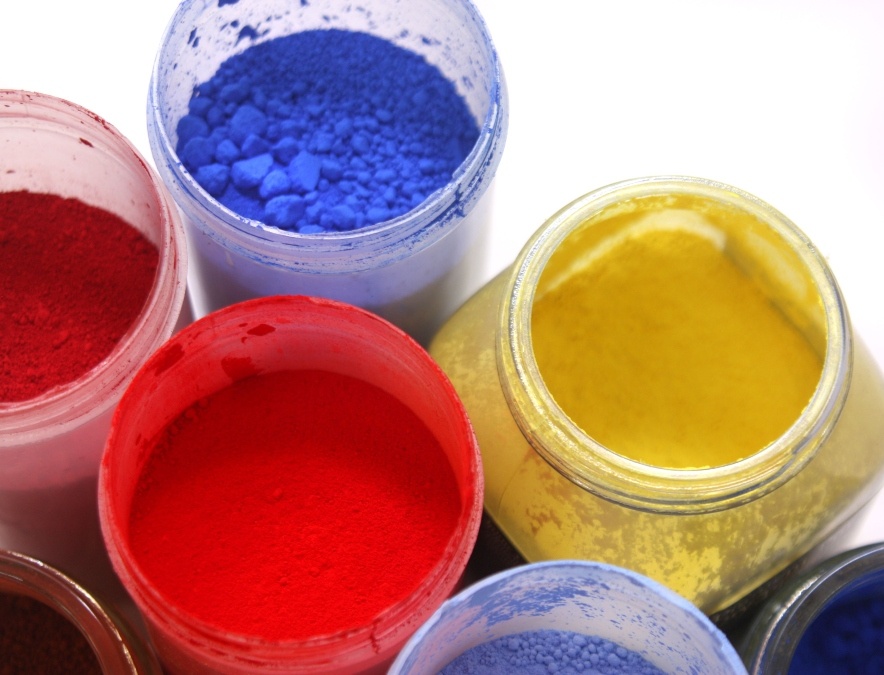Surface modifications of pigment particles often also bring other benefits such as improved coating durability.
by ENG. ORIETTA LEÓN
The simplest way to consider the effect of pigmentation on coating characteristics is to assume that the effect is proportional to the pigment content incorporated in the binder, regardless of the type of pigment and binder.
While this approach might be a good approximation for coatings containing a low proportion of inert pigments, for most coatings, in practice, such an approach leads to significant errors.
With a few exceptions, all coating properties can be described as a function of pigment volume concentration (PVC) or pigment volumetric fraction (φ), as they are primarily volume-dependent, as first mentioned in 1925 and clearly demonstrated in 1949.
PVC=VpVp+Vb100=WpdpWpdp+Wbdb100
where V, W and d represent pigment volume, weight and density, respectively. The p and b subscripts represent the pigment(s) and binder(s), respectively.
 An important practical and theoretical coating concept is the critical pigment volume concentration (CPVC) introduced by Asbeck and Van Loo.
An important practical and theoretical coating concept is the critical pigment volume concentration (CPVC) introduced by Asbeck and Van Loo.
The CPVC represents the PVC corresponding to the "packaging pigment particles as random as possible and the minimum amount of binder necessary to fill the gap between particles". The great importance of this concept lies in the fact that at this level of pigments practically all the properties of the coating change drastically.
Below the CPVC, the coating film is continuous and made only of binder and pigments. Above the CPVC, the film is discontinuous due to the presence of air pockets around the pigment particles that replace the binder.
CPVC is known to be affected by many factors such as the chemical nature of the charge and binder, particle size and load morphology, drying conditions and substrate type. For this reason, whenever the CPVC has to be known more accurately, it is suggested to determine it directly, rather than evaluating it from mathematical models.
While the determination of CPVC is useful for all types of coatings, for example industrial and architectural, for paper coatings it is imperative since they are formulated above CPVC for economic reasons.
In certain cases, the properties of the coating shall be represented as a function of Λ (reduced PVC, PVC/CPVC). Such a representation makes it possible to compare the properties of coatings at identical packaging effect on a given pigment volume.
Curing and film formation
Certain pigments are inert, while others interact with the binder. A consistent deviation of Newtonian flow, and changes in induction time, reaction rate, degree of reaction, enthalpy of reaction, gelation time and glass transition temperature are some of the indicators that pigments and binders are interacting.
 The surface of the pigments has a basic or acidic character, so they can react with the functional groups of the binder to form hydrogen bonding and even covalent bonds. As a result, in some cases the incorporation of pigments into a binder can affect the curing process of the respective paints. Despite its practical importance, this aspect has been little researched.
The surface of the pigments has a basic or acidic character, so they can react with the functional groups of the binder to form hydrogen bonding and even covalent bonds. As a result, in some cases the incorporation of pigments into a binder can affect the curing process of the respective paints. Despite its practical importance, this aspect has been little researched.
In work on ZnO (still used as a non-toxic fungidate) and red lead (currently little used due to its toxicity), it was shown that these pigments can react with ester groups of linseed oil, support oil, alkyds and similar products to form zinc and lead soaps, respectively.
Other studies indicated that certain pigments could have a great influence on the curing process, and even eliminate it completely. For example, thermograms obtained by differential scanning calorimetry (DSC) for the prepolymer diallyl phthalate, catalyzed by dicumyl peroxide, show that the type of pigment incorporated affects the reaction process.
Three pigments (silica, wollastonite and asbestos) have exothermic peaks, practically identical to those of the non-pigmented sample, indicating that they slightly affect the reaction process. In contrast, kaolinite clay virtually eliminates curing, as indicated by the presence of a small enthalpy of reaction.
The breakdown of the initiator by the acid groups present on the surface of the clay was considered as the cause of this effect. Powder coating chemists are well aware of the fact that pigment particles, e.g. TiO2 and carboxyll-functionalized resins, can interact leading to higher yield and viscosity values.
Parallel studies
Other research indicates that, depending on the type of yellow iron oxides, the curing process of powder coatings is affected differently.
 Today, to decrease or increase the reactivity of inorganic pigments, many are treated with inorganic or organic products. Surface modifications of pigment particles often also bring other benefits such as improved coating durability, improved pigment dispersion, change in paint rheology, and improved coating mechanical properties.
Today, to decrease or increase the reactivity of inorganic pigments, many are treated with inorganic or organic products. Surface modifications of pigment particles often also bring other benefits such as improved coating durability, improved pigment dispersion, change in paint rheology, and improved coating mechanical properties.
Several studies were devoted to the effect of pigmentation on the film formation of latex coatings. For example, despite the difficulty of such research, some studies were designed to look at the ways in which latex particles spread and arranged into inorganic pigments.
It was found that, in general, the arrangement and diffusion of latex particles are affected by the physical and chemical characteristics of latex particles and inorganic pigments, as well as by drying conditions.
One study indicated that an extender pigment, CaCO3, incorporated into a styrene/butyl acrylate latex copolymer does not modify the polymer structure. It was concluded that, at higher PVC, the extender pigment particles are fixed by isolated latex particles and that the polymer does not spread completely over the pigment.
Another research used a 2-ethylhexyl methyl methacrylate/acrylate latex copolymer loaded with two extender pigments (250-300 nm CaCO3 and 25 nm silica) to determine how high PVC affects coalescence and subsequent polymer diffusion processes.
The results obtained indicate the importance of the type of charge, its particle size and chemical nature, and the spatial arrangement of the pigment and latex particles, while both extender pigments do not interfere with the coalescence of latex particles, they affect differently the rate of interdiffusion of the polymer.
Up to 80% (by weight) of the 250-300 nm of CaCO3 has a negligible effect on the interdiffusion rate of the polymer, while 25 nm silica particles do so slowly, even in small amounts.
This retardation effect was attributed to the strong interaction between the polymer and the surface of the nanosilica. A similar retrocharging effect was also described when poly(methyl methacrylate) plastic pigments are incorporated into organic coatings.
References consulted
C.B. Ng, B. J Ash, L.S. Schadler, R.W. Siegel, 2001. A study of the mechanical and permeability properties of nano- and micron-TiO2 filled epoxy composites, Advanced Composites Letters, 10(3), 101-111.
C.J. Rieger, 1995. Pearlescent pigments, in: J.V. Koleske (Ed.), The Gardner Sward Handbook: Paint and Coating Testing Manual, vol. 17, 14th ed., ASTM Manual MNL, p. 229.
D.H. Solomon, D.G. Hawthorne, 1983. Chemistry of Pigments and Fillers, Willey/Interscience, New York.
D.Ik. Lee, 2002. The structure of model coatings: latex-bound plastic pigment coatings, Progress in Organic Coatings, 45, 341-358.
D.Y. Perera, 2003. Physical ageing of organic coatings, Progress in Organic Coatings, 47, 61-76.
E. Herrmann, 1976. Inorganic coloured pigments, in: G.D. Parfitt, K.S.W. Sing (Eds.), Characterization of Pigment Surfaces, Academic Press, London.
F.R. Spinelli, 1995. Black pigments, in: J.V. Koleske (Ed.), The Gardner Sward Handbook: Paint and Coating Testing Manual, vol. 17, 14th ed., ASTM Manual MNL, p. 179.
G.D. Shay, 1995. Thickeners and rheology modifiers, in: J.V. Koleske (Ed.), The Gardner Sward Handbook: Paint and Coating Testing Manual, vol. 17, 14th ed., ASTM Manual MNL, p. 268.
H.P. Ralston, 1995. Extender pigments, in: J.V. Koleske (Ed.), The Gardner Sward Handbook: Paint and Coating Testing Manual, vol. 17, 14th ed., ASTM Manual MNL, p. 217.
J. Oberdisse, 2002. Structure and rheological properties of latex-silica nanocomposite films: stress-strain isotherms, Macromolecules 35, 9441-9450.
J.H. Braun, 1995. White pigments, in: J.V. Koleske (Ed.), The Gardner Sward Handbook: Paint and Coating Testing Manual, vol. 17, 14th ed., ASTM Manual MNL, p. 159.
M. Kobayashi, Y. Rharbi, M.A. Winnik, 2001. Effect of inorganic pigments on polymer interdiffusion in a low-Tg latex film, Macromolecules, 34, 1855-1863.
M.J. Austin, 1995. Inorganic anti-corrosive pigments, in: J.V. Koleske (Ed.), The Gardner Sward Handbook: Paint and Coating Testing Manual, vol. 17, 14th ed., ASTM Manual MNL, p. 238.
Oil Colloidal Chemistry Association, Australia, 1983. Surface Coatings, vol. 1: Raw Materials and their Usage, Chapman & Hall, London.
Oil Colloidal Chemistry Association, Australia, 1984. Surface Coatings, vol. 2: Paint and their Applications, Tafe Educational Books.
P. Nylén, E. Sunderland, 1965. Modern Surface Coatings, Willey/Interscience, London.
P.A. Lewis, 1995. Colored organic pigments, in: J.V. Koleske (Ed.), The Gardner Sward Handbook: Paint and Coating Testing Manual, vol. 17, 14th ed., ASTM Manual MNL, p. 190.
P.A. Lewis, 1995. Inorganic colored pigments, in: J.V. Koleske (Ed.), The Gardner Sward Handbook: Paint and Coating Testing Manual, vol. 17, 14th ed., ASTM Manual MNL, p. 209.
R.L. Ferguson, 1995. Metallic pigments, in: J.V. Koleske (Ed.), The Gardner Sward Handbook: Paint and Coating Testing Manual, vol. 17, 14th ed., ASTM Manual MNL, p. 223.
S. Paul (ed.), 1966. Surface coatings, Science and Technology, Wiley, New York.
S. Zhou, L. Wu, J. Sun, W. Shen, The change of the properties of acrylic-based polyurethane via addition of nano-silica. Progress in Organic Coatings, 45, 33-42.
S.H. Mansour, 2000. J. Elastomers Plast., 32.
S.L. Simon, G.B. McKenna, 2000. Quantitative analysis of errors in TMDSC in the glass transition region, Thermochimica Acta, 348, 77-89.
T.C. Patton (ed.), 1973. Pigment Handbook, Willey/Interscience, New York.
V. Kovacevic, S. Lucic, M. Lescovac, 2002. Morphology and failure in nanocomposites. Part I: Structural and mechanical properties, Journal of Adhesion Science and Technology, 16(10), 1343-1365.


























Leave your comment